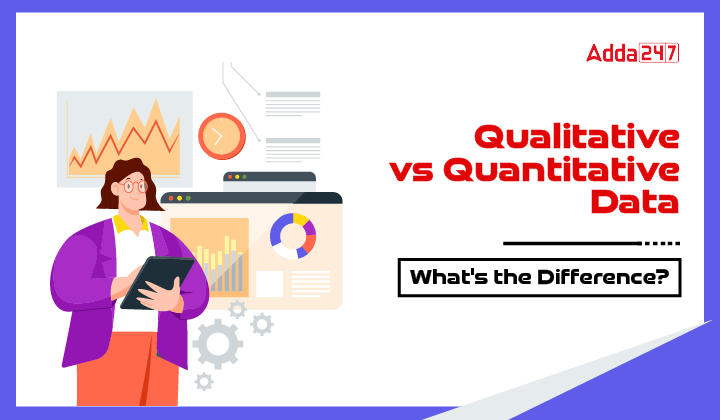Table of Contents
Data is a collection of words, numbers, facts, observations, measurements or facts for analysis, and interpretation. Data can be of various types. Generally, there are two types of data qualitative data and quantitative data. Qualitative data describes the qualities and characteristics. It is descriptive and expressed via language rather than numerical values. Quantitative data refers to numerical data or anything that can be measurable and countable. In this article further we will talk about types of data in depth and explores more about it.
Types of Data
Qualitative and quantitative data are two fundamental types of research data used in various fields, and they differ in their characteristics, methods of collection, and the types of information they provide.
Qualitative data
Unlike quantitative data, qualitative data cannot be measured and counted. It is descriptive data expressed through words and language. Qualitative data is subjective and dynamic. It describes certain attributes and helps us to understand the why or how behind certain behaviours. Qualitative data is analyzed by grouping the data into meaningful themes or categories.
Types of qualitative data
- Nominal data: Nominal data can be identified by particular names or categories. It cannot be quantified. The values are allocated to distinct categories. Those categories have no meaningful order. There is no hierarchy in nominal data. Nominal data are categorical. Examples are Gender ( Men, Women), hair colour ( blonde, brown, black), and eye colour ( blue, green, brown).
- Ordinal data: Ordinal data refers to data that is placed into some kind of order by their position on a scale. It may indicate superiority. Ordinal data has a natural rank and order. The ranks which are assigned to variables are hierarchical ranging from highest to lowest. Ordinal data are both quantitative and categorical. Here are some examples: Customer level of satisfaction: Very satisfied, Satisfied, Neutral, Dissatisfied, Very dissatisfied. Economic status: Low, Medium, High.
How to collect qualitative data?
Qualitative data can collect through various methods such as interviews, case studies, online surveys, observational studies, written documents, open-form surveys, support feedback, expert opinions, focus groups etc.
Quantitative data
Quantitative data refers to any information that can be quantified in numeric terms. It can be measured or analyzed by using statistical techniques. Quantitative data is fixed and universal. It is gathered by measuring and counting things. It is collected when researchers are trying to quantify a problem or address the how many, how much, and how often aspects of the research question. Here are some examples of quantitative data:
- Measurements such as height, weight and length: she is 5 feet and 7 inches tall
- Counts such as number of sales or revenue: 2, 00, 000 rupees generated by XYZ Ltd company.
Types of Quantitative data
- Discrete data: Discrete data is quantitative data that has fixed numerical values. Data that can be counted and has finite value is known as discrete data. It refers to the data which is countable. It is a type of data that has clear spaces between values. It contains distinct and separate values. Whole numbers are used to write discrete data. To represent discrete data researchers use pie charts, bar charts or bar graphs. For example, several players participated in a race.
- Continuous data: Continuous data refers to data that have values that are not fixed and have an infinite number of possible values. In this variables can take any value within a range. We cannot count but measure the values in a continuous data series. It falls in a constant sequence. Real numbers are used to write continuous data values. To represent continuous data histograms or line graphs are used. For example, The time taken by each player to finish the race.
- Interval Data: Interval is a type of data in which each point is placed at an equal distance from one another. It is a level of measurement that’s numerical but that doesn’t have a meaningful zero point the zero is arbitrary. Which means interval data can contain negative values. For example temperature in Celsius or Fahrenheit.
- Ratio Data: It is the most sophisticated level of measurement, having the same properties as interval data, it is ordered or ranked and the numerical distance between the points is consistent. However, it also has a true zero. Examples of ratio data are the temperature in Kelvin (zero Kelvin means 0 heat), and length of time duration.
How to collect Quantitative data?
Quantitative data can collect through several methods like experiments, controlled observations, longitudinal studies, telephone interviews, face-to-face interviews, metrics dashboards, structured surveys etc.
Difference between Quantitative and Qualitative data
Here are some same points which differentiate them from one another. Check the difference between Quantitative and Qualitative Data.
| Basis of difference | Qualitative data | Quantitative data |
| Type of information | It refers to data that consists of descriptive statements. | It refers to the type of data that can be measured and expressed numerically |
| Focus | It focuses on information about the quality of an object, which cannot be measured | It focuses on Information about the quantity of an object, hence it can be measured |
| Sub-categories | Types: nominal data and ordinal data | Types: interval data, Discrete, scale and ratio data |
| Structured or Unstructured | Unstructured data that needs interpretation | Structured and searchable data |
| Complexity of analysis | Statistical analysis is harder | Statistical analysis is easier |
| Methods for data collection | Collected using interviews, observations | Collected using surveys, experiments |
| Example | Example: the team is well-prepared | Example: the team has 11 players |
Conclusion
Quantitative and qualitative data have their strengths and limitations. They are often used together in research and decision-making process. Both are used in various fields to gather information and analyze trends. They are most commonly used in market research, education, business and economics and environmental studies.
Download Qualitative and quantitative data Study Notes PDF




 UGC NET Commerce Syllabus 2025 PDF Downl...
UGC NET Commerce Syllabus 2025 PDF Downl...
 UGC NET Teaching Aptitude Questions Answ...
UGC NET Teaching Aptitude Questions Answ...
 UGC NET Philosophy Syllabus 2025 PDF Dow...
UGC NET Philosophy Syllabus 2025 PDF Dow...




